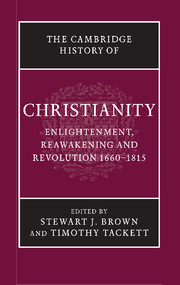Book contents
- Frontmatter
- Introduction
- PART I CHURCH, STATE, AND SOCIETY IN THE EUROPEAN WORLD, 1660–1780
- PART II CHRISTIAN LIFE IN THE EUROPEAN WORLD, 1660–1780
- PART III MOVEMENTS AND CHALLENGES
- PART IV CHRISTIAN DEVELOPMENTS IN THE NON-EUROPEAN WORLD
- 19 Christianity in Iberian America
- 20 British and French North America to 1765
- 21 Christianity in Africa
- 22 Christianity in south and south-east Asia
- 23 Christianity in East Asia
- 24 Christian encounters with other world religions
- PART V REVOLUTION AND THE CHRISTIAN WORLD
- Chronology
- Bibliography
- Index
- References
22 - Christianity in south and south-east Asia
from PART IV - CHRISTIAN DEVELOPMENTS IN THE NON-EUROPEAN WORLD
Published online by Cambridge University Press: 28 March 2008
- Frontmatter
- Introduction
- PART I CHURCH, STATE, AND SOCIETY IN THE EUROPEAN WORLD, 1660–1780
- PART II CHRISTIAN LIFE IN THE EUROPEAN WORLD, 1660–1780
- PART III MOVEMENTS AND CHALLENGES
- PART IV CHRISTIAN DEVELOPMENTS IN THE NON-EUROPEAN WORLD
- 19 Christianity in Iberian America
- 20 British and French North America to 1765
- 21 Christianity in Africa
- 22 Christianity in south and south-east Asia
- 23 Christianity in East Asia
- 24 Christian encounters with other world religions
- PART V REVOLUTION AND THE CHRISTIAN WORLD
- Chronology
- Bibliography
- Index
- References
Summary
This chapter will explore the spread of Christianity from the sixteenth to the early nineteenth centuries within the various parts of undivided India and, more briefly, in some other areas of south and south-east Asia. We will begin with India. The history of India goes back some 5,000 years to the Indus Valley civilization with its sophisticated urban culture found in the cities of Harappa and Mohenjo-Daro. The Indo-Aryan civilization probably came to India from central Asia around 1500 BC and formed much of India’s living tradition and impressive religious system. Indian culture was always a rich mosaic of new elements and foreign influences merged into its ancient roots.
The oldest of its religious traditions was Hinduism. Under the broad rubric of Hinduism, there existed an enormous fluidity of beliefs and practices which in turn evolved by interacting with the other religions of India. Hinduism was a way of life. It had no single book or god or prophet and every village could have its own deity. It was a religion of deep philosophy and metaphysics, existing side by side with rituals and ceremonies that marked the days, seasons and events in life. Gods were either distant or near, and were part of every household and clan. One worshipped them through silent meditation, communal singing, or joyful festivity. Closely linked to this religious system was a social system. Society came to be divided into four castes, the Brahmans (priestly class in charge of the rituals and chants), the Kshatriyas (warriors), the Vaishyas (merchants), and the Shudras (menial workers).
- Type
- Chapter
- Information
- The Cambridge History of Christianity , pp. 433 - 450Publisher: Cambridge University PressPrint publication year: 2006

